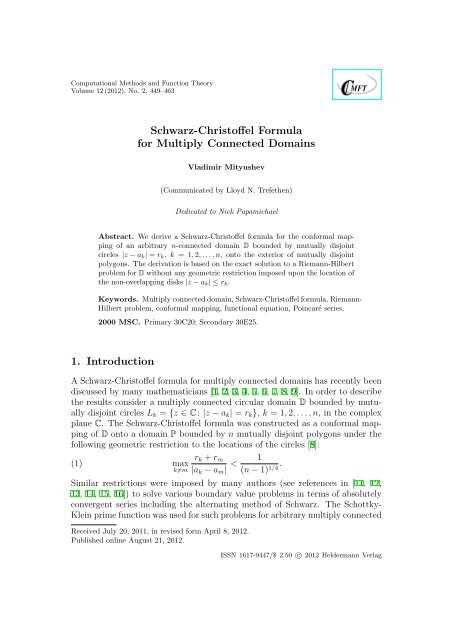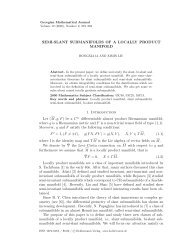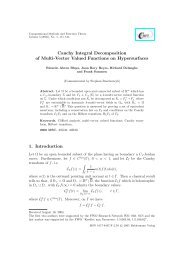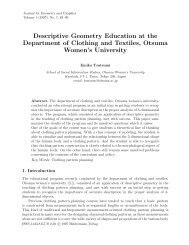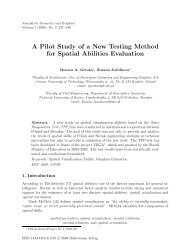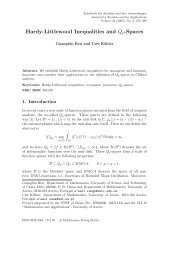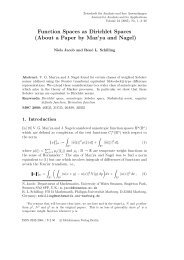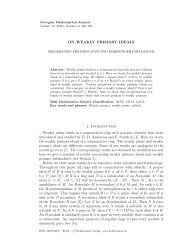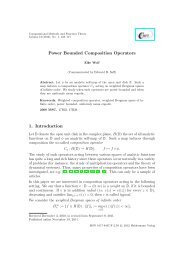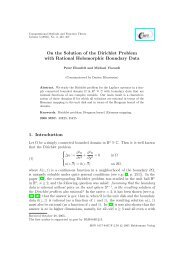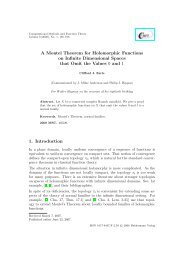Schwarz-Christoffel Formula for Multiply Connected Domains
Schwarz-Christoffel Formula for Multiply Connected Domains
Schwarz-Christoffel Formula for Multiply Connected Domains
Create successful ePaper yourself
Turn your PDF publications into a flip-book with our unique Google optimized e-Paper software.
Computational Methods and Function Theory<br />
Volume 12 (2012), No. 2, 449–463<br />
<strong>Schwarz</strong>-<strong>Christoffel</strong> <strong>Formula</strong><br />
<strong>for</strong> <strong>Multiply</strong> <strong>Connected</strong> <strong>Domains</strong><br />
Vladimir Mityushev<br />
(Communicated by Lloyd N. Trefethen)<br />
Dedicated to Nick Papamichael<br />
Abstract. We derive a <strong>Schwarz</strong>-<strong>Christoffel</strong> <strong>for</strong>mula <strong>for</strong> the con<strong>for</strong>mal mapping<br />
of an arbitrary n-connected domain D bounded by mutually disjoint<br />
circles |z − a k | = r k , k = 1, 2, . . . , n, onto the exterior of mutually disjoint<br />
polygons. The derivation is based on the exact solution to a Riemann-Hilbert<br />
problem <strong>for</strong> D without any geometric restriction imposed upon the location of<br />
the non-overlapping disks |z − a k | ≤ r k .<br />
Keywords. <strong>Multiply</strong> connected domain, <strong>Schwarz</strong>-<strong>Christoffel</strong> <strong>for</strong>mula, Riemann-<br />
Hilbert problem, con<strong>for</strong>mal mapping, functional equation, Poincaré series.<br />
2000 MSC. Primary 30C20; Secondary 30E25.<br />
1. Introduction<br />
A <strong>Schwarz</strong>-<strong>Christoffel</strong> <strong>for</strong>mula <strong>for</strong> multiply connected domains has recently been<br />
discussed by many mathematicians [1, 2, 3, 4, 5, 6, 7, 8, 9]. In order to describe<br />
the results consider a multiply connected circular domain D bounded by mutually<br />
disjoint circles L k = {z ∈ C: |z − a k | = r k }, k = 1, 2, . . . , n, in the complex<br />
plane C. The <strong>Schwarz</strong>-<strong>Christoffel</strong> <strong>for</strong>mula was constructed as a con<strong>for</strong>mal mapping<br />
of D onto a domain P bounded by n mutually disjoint polygons under the<br />
following geometric restriction to the locations of the circles [8]:<br />
(1) max<br />
k≠m<br />
r k + r m<br />
|a k − a m | < 1<br />
(n − 1) 1/4 .<br />
Similar restrictions were imposed by many authors (see references in [11, 12,<br />
13, 14, 15, 16]) to solve various boundary value problems in terms of absolutely<br />
convergent series including the alternating method of <strong>Schwarz</strong>. The Schottky-<br />
Klein prime function was used <strong>for</strong> such problems <strong>for</strong> arbitrary multiply connected<br />
Received July 20, 2011, in revised <strong>for</strong>m April 8, 2012.<br />
Published online August 21, 2012.<br />
ISSN 1617-9447/$ 2.50 c○ 2012 Heldermann Verlag
450 V. Mityushev CMFT<br />
domains [1, 2, 3, 4, 5]. However, explicit <strong>for</strong>mulae <strong>for</strong> the Schottky-Klein prime<br />
function are known only under the restriction (1).<br />
In the present paper, we follow the method presented in [15] which is based on the<br />
construction of the con<strong>for</strong>mal mapping via exact solution of a Riemann-Hilbert<br />
boundary value problem [11, 13, 14, 16] and on the uni<strong>for</strong>mly convergent Poincaré<br />
series [12] <strong>for</strong> the classical Schottky groups. As a result we explicitly obtain<br />
the <strong>Schwarz</strong>-<strong>Christoffel</strong> <strong>for</strong>mula <strong>for</strong> arbitrary domains D without any geometric<br />
restriction. In order to construct the con<strong>for</strong>mal mapping we solve the following<br />
Riemann-Hilbert problem [8]<br />
(2) Re[(t − a k )ψ(t)] = −1, |t − a k | = r k , k = 1, 2, . . . , n,<br />
<strong>for</strong> the function ψ(z) analytic in D and continuous in D ∪ ∂D except at the point<br />
singularities on the boundary ∂D prescribed below.<br />
2. Preliminaries<br />
The clockwise orientation is taken on each L k , hence the boundary ∂D = ⋃ n<br />
k=1 L k<br />
has the domain D to the left. First, we normalize the required con<strong>for</strong>mal mapping<br />
f : D → P by the condition f(∞) = ∞. Let the boundary of the domain P consist<br />
of n mutually disjoint polygons Γ k = f(L k ) with P lying to the left. Let the M k<br />
vertices of Γ k be denoted by w lk , l = 1, 2, . . . , M k , numbered clockwise around<br />
Γ k <strong>for</strong> each k = 1, 2, . . . , n. The corresponding vertex angles of the Γ k at the<br />
vertices w lk , measured from the exterior of P, are introduced as π(1+β lk ), where<br />
πβ lk is the turning of the tangent at w lk . The constants β lk satisfy the inequality<br />
−1 < β lk ≤ 1 and the relations<br />
(3)<br />
∑M k<br />
l=1<br />
β lk = 2, k = 1, 2, . . . , n.<br />
The prevertices are denoted by z lk with f(z lk ) = w lk .<br />
Our study is based on the fact established in [8] that the pre<strong>Schwarz</strong>ian<br />
(4) S(z) = f ′′ (z)<br />
f ′ (z)<br />
is one of the solutions of the Riemann-Hilbert problem (2) in the class of functions<br />
having prescribed singularities at the points z lk ∈ L k , l = 1, 2, . . . , M k ,<br />
k = 1, 2, . . . , n, where<br />
(5) S(z) ∼ β lk<br />
z − z lk<br />
as z → z lk .<br />
In order to recover f(z) from S(z) one can integrate twice the relation (4) since<br />
S(z) = (ln f ′ (z)) ′ . The primitive function<br />
(6) ω(z) =<br />
∫ z<br />
S(ζ) dζ
12 (2012), No. 2 <strong>Schwarz</strong>-<strong>Christoffel</strong> <strong>Formula</strong> <strong>for</strong> <strong>Multiply</strong> <strong>Connected</strong> <strong>Domains</strong> 451<br />
yields the <strong>Schwarz</strong>-<strong>Christoffel</strong> integral<br />
(7) f(z) =<br />
∫ z<br />
exp(ω(ζ)) dζ.<br />
The pre<strong>Schwarz</strong>ian and exp(ω(ζ)) were constructed by DeLillo et al. [8] by infinite<br />
sequences of iterated reflections that generate a series which absolutely converges<br />
under the restriction (1) (<strong>for</strong> details see [8] and the next section)<br />
⎡<br />
⎤<br />
(8) exp(ω(z)) =<br />
n∏ ∏M m<br />
⎣ ∏<br />
m=1 l=1<br />
γ o∈O ′ m<br />
z − γ o (z lm )<br />
z − γ o (a m )<br />
∏<br />
γ e∈E ′ m<br />
z − γ e (z lm )<br />
z − γ e (a m )<br />
⎦β lm<br />
.<br />
In the present paper, we follow another method based on the Riemann-Hilbert<br />
problem (2) in the class of functions satisfying the asymptotic <strong>for</strong>mulae (5).<br />
General solution ψ(z) of the problem (2) contains n arbitrary real constants [15],<br />
say ξ 1 , . . . , ξ n , i.e. ψ(z) = ψ(z; ξ 1 , . . . , ξ n ). In order to construct the required<br />
functions S(z) and ω(z), we first construct the functions ψ(z; ξ 1 , . . . , ξ n ) and<br />
Ω(z; ξ 1 , . . . , ξ n ). Further, the arbitrary constants ξ 1 , . . . , ξ n are chosen in such a<br />
way that ψ(z; ξ 1 , . . . , ξ n ) yields S(z) and Ω(z; ξ 1 , . . . , ξ n ) yields ω(z).<br />
3. Schottky group<br />
The inversion of z through the circle L k is given by<br />
z ∗ (k) = r k 2<br />
z − a k<br />
+ a k .<br />
It is known that if a function Φ(z) is analytic in the disk |z − a k | < r k and<br />
continuous in its closure, then Φ(z ∗ (k) ) is analytic in |z − a k| > r k and continuous<br />
in |z − a k | ≥ r k .<br />
Introduce the composition of successive inversions through the circles L k1 , L k2 ,<br />
. . . , L kp<br />
( ) ∗<br />
(9) z(k ∗ pk p−1 ...k 1 ) := z(k ∗ p−1 ...k 1 ) .<br />
(k p)<br />
In the sequence k 1 , k 2 , . . . , k p no two neighboring numbers are equal. The number<br />
p is called the level of the mapping. When p is even, these are Möbius<br />
trans<strong>for</strong>mations. If p is odd, we have anti-Möbius trans<strong>for</strong>mations, i.e., Möbius<br />
trans<strong>for</strong>mations in z. Thus, these mappings can be written in the <strong>for</strong>m<br />
(10a)<br />
(10b)<br />
γ j (z) = e jz + b j<br />
c j z + d j<br />
<strong>for</strong> p ∈ 2Z,<br />
γ j (z) = e jz + b j<br />
c j z + d j<br />
<strong>for</strong> p ∈ 2Z + 1,
452 V. Mityushev CMFT<br />
where e j d j − b j c j = 1, j = 0, 1, 2, . . .. Here<br />
γ 0 (z) := z<br />
(identical mapping with the level p = 0),<br />
γ 1 (z) := z ∗ (1), . . . , γ n (z) := z ∗ (n)<br />
(n simple inversions, p = 1),<br />
γ n+1 (z) := z ∗ (12), γ n+2 (z) := z ∗ (13), . . . , γ n 2(z) := z ∗ (n,n−1)<br />
(n 2 − n double inversions, p = 2),<br />
γ n 2 +1(z) := z ∗ (121), . . .<br />
and so on.<br />
The set of the subscripts j of γ j is ordered in such a way that the level p is increasing.<br />
The functions (10) generate a Schottky group K. Thus, each element of K<br />
is presented in the <strong>for</strong>m of the composition of inversions (9) or in the <strong>for</strong>m of linearly<br />
ordered functions (10). Let K m be a subset of K such that the last inversion<br />
of each element of K m is different from z ∗ (m) , i.e. K m = {z ∗ (k pk p−1 ...k 1 ) : k p ≠ m}.<br />
The set K ′ m = {z ∗ (k pk p−1 ...k 1 ) : k 1 ≠ m} is introduced similarly. All elements γ j<br />
of the even levels generate a subgroup E of the group K. The set of the elements<br />
γ j of odd level K\E is denoted by O. Introduce the notation E m = E ∩K m ,<br />
O m = O ∩ K m and E ′ m = E ∩ K ′ m, O ′ m = O ∩ K ′ m.<br />
Let us fix an inversion z(m) ∗ . Consider the trans<strong>for</strong>mation<br />
γ j (z) = ( γt<br />
−1 (z) ) ∗<br />
(m)<br />
from E, where γt<br />
−1<br />
have<br />
(11)<br />
is the inverse trans<strong>for</strong>mation to γ t ∈ O ′ m. Then from [15] we<br />
ζ − γ j (z)<br />
ζ − γ j (w) = z − γ t(ζ(m) ∗ )<br />
w − γ t (ζ(m) ∗ ) · w − γ t(a m )<br />
z − γ t (a m ) .<br />
Consider now a trans<strong>for</strong>mation γ j ∈ O and<br />
from E ′ m. Then [15]<br />
(12)<br />
( )<br />
γ s (z) = γ −1<br />
j z(m)<br />
∗<br />
( ) ζ − γj (w)<br />
= w − γ s(ζ(m) ∗ )<br />
ζ − γ j (z) z − γ s (ζ(m) ∗ ) · z − γ s(a m )<br />
w − γ s (a m ) .
12 (2012), No. 2 <strong>Schwarz</strong>-<strong>Christoffel</strong> <strong>Formula</strong> <strong>for</strong> <strong>Multiply</strong> <strong>Connected</strong> <strong>Domains</strong> 453<br />
4. Reduction of the Riemann-Hilbert problem to<br />
functional equations<br />
It follows from [15] that the inhomogeneous Riemann-Hilbert problem (2) always<br />
has solutions. The general solution amounts of a particular solution of the inhomogeneous<br />
problem and a linear combination of n solutions of the homogeneous<br />
problem.<br />
In order to solve the problem (2) rewrite it in the <strong>for</strong>m of the R-linear problem<br />
(13)<br />
(t − a k )ψ(t) = (t − a k )ψ k (t) − (t − a k )ψ k (t) − 1 + iξ k ,<br />
|t − a k | = r k , k = 1, . . . , n.<br />
Here, ξ k are undetermined real constants, ψ k (z) is analytic in |z − a k | < r k ,<br />
continuous in |z − a k | ≤ r k except the points z lk , where<br />
(14) ψ k (z) ∼<br />
β lk<br />
2(z − z lk )<br />
as z → z lk .<br />
It will be shown below in Lemma 1 that the asymptotics (14) and (5) <strong>for</strong> ψ(z)<br />
are matched. Hence, the R-linear problem (13) must be stated in a class of<br />
functions with prescribed singularities. It is convenient to describe this class by<br />
introduction of the Banach spaces as follows.<br />
Let G be a domain on the extended complex plane. Introduce the Banach space<br />
C(∂G) of functions continuous on ∂G with the norm<br />
‖F ‖ = max |F (t)|.<br />
t∈∂G<br />
Let us consider a closed subspace C A (G) of C(∂G) consisting of functions analytically<br />
continued into G. The Maximum Principle implies that convergence in<br />
the space C A (G) is equivalent to uni<strong>for</strong>m convergence in the closure of G. Let<br />
a fixed function F 0 have a finite number of singularities on the boundary ∂G.<br />
Introduce the space<br />
of functions endowed with the norm<br />
C A (G, F 0 ) = {F : F − F 0 ∈ C A (G)}<br />
‖F ‖ CA (G,F 0 ) = max<br />
t∈∂G |F (t) − F 0(t)|.<br />
The spaces C A (G, F 0 ) and C A (G) are isomorphic.<br />
Introduce mutually disjointed disks<br />
D k = {z ∈ C: |z − a k | < r k }, k = 1, 2, . . . , n.<br />
The multiply connected domain D complements all the closed disks D k ∪ L k to<br />
the extended complex plane Ĉ = C ∪ {∞}, i.e.<br />
n<br />
D = Ĉ\ ⋃<br />
(D k ∪ L k ).<br />
k=1
454 V. Mityushev CMFT<br />
Introduce the function<br />
(15) Φ(z) =<br />
where<br />
(16) Φ k (z) = 1 2<br />
n∑<br />
Φ k (z),<br />
k=1<br />
∑M k<br />
l=1<br />
β lk<br />
z − z lk<br />
.<br />
Then ψ(z) ∈ C A (D, 2Φ) and ψ k (z) ∈ C A (D k , Φ k ). The problems (2) and (13) in<br />
the classes considered are equivalent in the sense of the following result.<br />
Lemma 1.<br />
(i) If ψ(z) and ψ k (z) are solutions of (13) in the class considered, then ψ(z)<br />
satisfies (2).<br />
(ii) If ψ(z) is a solution of (2), there exist functions ψ k ∈ C A (D k , Φ k ) and real<br />
constants ξ k such that the R-linear conditions (13) are fulfilled.<br />
Proof. The proof of the first assertion is evident. It is sufficient to take the real<br />
part of (13).<br />
Conversely, let ψ(z) satisfy (2). The function<br />
Ψ k (z) = iξ k<br />
2 + (z − a k)ψ k (z)<br />
can be uniquely determined from the simple <strong>Schwarz</strong> problem <strong>for</strong> the disk D k<br />
[10, 16]<br />
(17) 2 Im Ψ k (t) = Im(t − a k )ψ(t), |t − a k | = r k .<br />
It is assumed that the function Ψ k (z) is continuous in |z − a k | ≤ r k except at<br />
the points z lk , where the principal part β lk (z lk − a k )/[2(z − z lk )] of Ψ k (z) is<br />
determined by the right hand part of (17). The problem (17) <strong>for</strong> the function<br />
Ψ k (z) has a unique solution, since Re Ψ k (a k ) = 0. There<strong>for</strong>e, the function<br />
ψ k (z) and the constant ξ k are uniquely determined in terms of ψ(z) <strong>for</strong> each<br />
k = 1, . . . , n. Direct calculations yields the asymptotic (14).<br />
Hence the lemma is proved.<br />
We now proceed to solve the R-linear problem (13) written in the <strong>for</strong>m<br />
( ) 2 rk<br />
(18) ψ(t) = ψ k (t) − ψ k (t) − 1 − iξ k<br />
, |t − a k | = r k , k = 1, . . . , n.<br />
t − a k t − a k
12 (2012), No. 2 <strong>Schwarz</strong>-<strong>Christoffel</strong> <strong>Formula</strong> <strong>for</strong> <strong>Multiply</strong> <strong>Connected</strong> <strong>Domains</strong> 455<br />
Introduce the function<br />
⎧<br />
(<br />
rm<br />
ψ k (z) + ∑ ) 2<br />
ψ m (z(m) ∗ ⎪⎨<br />
z − a ) + ∑ m<br />
m≠k<br />
m≠k<br />
˜Φ(z) :=<br />
n∑<br />
( ) 2 rm<br />
n∑<br />
⎪⎩ ψ(z) +<br />
ψ m (z(m) ∗ z − a ) +<br />
m<br />
m=1<br />
Calculate its jump across the circle L k<br />
∆ k :=<br />
m=1<br />
1 − iξ m<br />
z − a m<br />
, |z − a k | ≤ r k ,<br />
1 − iξ m<br />
z − a m<br />
, z ∈ D.<br />
lim ˜Φ(z) − lim ˜Φ(z), t ∈ Lk .<br />
z→t z∈D<br />
z→t z∈D k<br />
Using (18) we get ∆ k = 0. It follows from the Analytic Continuation Principle<br />
that ˜Φ (z) is analytic in the extended complex plane except at the points z lk . A<br />
straight<strong>for</strong>ward calculation shows that ˜Φ(z) has the same asymptotics as Φ(z)<br />
from (15). Then the generalized Liouville theorem implies that ˜Φ(z) coincides<br />
with Φ(z). Here, the relation ˜Φ(∞) = 0 is used. The definition (15) of Φ(z) in<br />
|z − a k | ≤ r k yields the following system of functional equations<br />
ψ k (z) = ∑ ( ) 2 rm<br />
)<br />
ψ m<br />
(z(m)<br />
∗ − ∑ 1 − iξ m<br />
(19)<br />
+ Φ(z),<br />
z − a m z − a m<br />
m≠k<br />
m≠k<br />
|z − a k | ≤ r k , k = 1, . . . , n.<br />
The general solution of the Riemann-Hilbert problem (2) is constructed via ψ k (z)<br />
(see the definition of ˜Φ(z) in D)<br />
n∑<br />
( ) 2 rm<br />
) n∑<br />
ψ(z) = −<br />
ψ m<br />
(z ∗ 1 − iξ m<br />
(20)<br />
(m)<br />
−<br />
+ Φ(z),<br />
z − a m z − a m<br />
m=1<br />
z ∈ D ∪ ∂D.<br />
The function ψ(z) is analytic in D except at the points z lk where its principal<br />
part is β lk /(z − z lk ).<br />
m=1<br />
5. Solution to functional equations<br />
Lemma 2. The system of functional equations (19) has a unique solution in<br />
C A (D k , Φ k ) (k = 1, 2, . . . , n). This solution can be found by the method of successive<br />
approximations.<br />
Proof. The proof of the lemma follows from [16, Lem. 4.8, p. 167] and [14]<br />
where functional equations had been solved in C A (D k ). Introduce the function χ k<br />
analytic in |z − a k | < r k and continuous in |z − a k | ≤ r k defined by<br />
(21) χ k (z) = ψ k (z) − Φ k (z),
456 V. Mityushev CMFT<br />
i.e. χ k ∈ C A (D k ). Substitution of (21) into (19) yields the system of functional<br />
equations in C A (D k ), k = 1, 2, . . . , n,<br />
χ k (z) = − ∑ ( ) 2 rm<br />
)<br />
(22)<br />
χ m<br />
(z(m)<br />
∗ + h k (z),<br />
z − a m<br />
m≠k<br />
where<br />
(23) h k (z) = − ∑ m≠k<br />
|z − a k | ≤ r k , k = 1, . . . , n,<br />
1 − iξ m<br />
+ Φ(z) − Φ k (z) − ∑ ( ) 2 rm<br />
)<br />
Φ m<br />
(z(m)<br />
∗ z − a m z − a m<br />
m≠k<br />
belongs to C A (D k ) (see (15) and (16)). It follows from [16, 14] that the system of<br />
functional equations (22) has a unique solution in C A (D k ). This solution χ k (z)<br />
can be found by the method of uni<strong>for</strong>mly convergent successive approximations.<br />
Then (21) yields ψ k (z) = Φ k (z) + χ k (z). Hence, ψ k (z) can be found by the<br />
method of successive approximations applied to (19). Convergence of the series<br />
<strong>for</strong> ψ k (z) is uni<strong>for</strong>m in every compact subset of D k ∪ ∂D k \ ⋃ M k<br />
l=1 {z lk}.<br />
This completes the proof of the lemma.<br />
It is possible to write ψ k explicitly in the <strong>for</strong>m of a series. But ultimately a<br />
primitive of ψ k is needed. In order to properly define it we fix a point w ∈ D\{∞}<br />
and introduce the functions<br />
(24) ϕ m (z) =<br />
and<br />
(25)<br />
Ω(z) =<br />
n∑<br />
m=1<br />
−<br />
∫ z<br />
w ∗ (m)<br />
ψ m (ζ) dζ + ϕ m (w ∗ (m)), m = 1, 2, . . . , n,<br />
( ) ( ) [ϕ ]<br />
m z(m)<br />
∗ − ϕ m w(m)<br />
∗<br />
n∑<br />
(1 − iξ m ) ln a m − z<br />
a m − w + 1 2<br />
m=1<br />
n∑ ∑M m<br />
m=1 l=1<br />
β lm ln z lm − z<br />
z lm − w ,<br />
where a single valued branch of the logarithm is fixed in such a way that all cuts<br />
of<br />
ln a m − z<br />
a m − w , ln z lm − z<br />
z lm − w<br />
lie in D ∪ D m ∪ ∂D m and ln x is real <strong>for</strong> positive x → +∞. In calculating the<br />
integral (24), the following relation is used [16]<br />
d<br />
(<br />
(26)<br />
[ϕ m z ∗<br />
dz<br />
(m)) ] ( ) 2 rk dϕ<br />
( )<br />
m<br />
= −<br />
z(m)<br />
∗ , |z − a k | > r k .<br />
z − a k dz
12 (2012), No. 2 <strong>Schwarz</strong>-<strong>Christoffel</strong> <strong>Formula</strong> <strong>for</strong> <strong>Multiply</strong> <strong>Connected</strong> <strong>Domains</strong> 457<br />
The functions Ω(z) and ϕ m (z) belong to<br />
)<br />
n∑ ∑M m<br />
C A<br />
(D, β lm ln(z − z lm )<br />
and to<br />
m=1 l=1<br />
(<br />
)<br />
C A D m , 1 ∑M m<br />
β lm ln(z − z ml ) ,<br />
2<br />
l=1<br />
respectively. One can see from (24) that the function ϕ m (z) is determined by<br />
ψ m (z) up to an additive constant which vanishes in (25). The function Ω(z)<br />
vanishes at z = w.<br />
Integrate each functional equation (19). Application of (24) yields functional<br />
equations<br />
ϕ k (z) = ∑ ( ) ( ) [ϕ ] m z(m)<br />
∗ − ϕ m w(m)<br />
∗ − ∑ (1 − iξ m ) ln a m − z<br />
(27)<br />
a m − w<br />
m≠k<br />
m≠k<br />
<strong>for</strong> the functions<br />
+ 1 2<br />
n∑ ∑M m<br />
m=1 l=1<br />
β lm ln z − z lm<br />
w − z lm<br />
+ c k , |z − a k | ≤ r k , k = 1, . . . , n,<br />
ϕ k ∈ C A<br />
(<br />
and undetermined constants c k .<br />
D k , 1 2<br />
∑M k<br />
l=1<br />
β lk ln(z − z lk )<br />
Lemma 3. The system of functional equations (27) with fixed c k has a unique<br />
solution in<br />
(<br />
)<br />
C A D k , 1 ∑M k<br />
β lk ln(z − z lk ) , k = 1, . . . , n.<br />
2<br />
l=1<br />
This solution can be found by the method of successive approximations.<br />
Proof. The proof follows from Lemma 2, since (27) is the result of the integral<br />
operator<br />
(28) F ↦→<br />
applied to (19). Convergence in<br />
C A<br />
(<br />
D k , 1 2<br />
∫ z<br />
∑M k<br />
l=1<br />
w ∗ (k)<br />
F (t)dt<br />
β lk ln(z − z lk )<br />
)<br />
)
458 V. Mityushev CMFT<br />
means uni<strong>for</strong>m convergence in every compact subset of<br />
⋃M k<br />
(D k ∪ ∂D k )\ {z lk }.<br />
There<strong>for</strong>e, the integral operator (28) can be applied term by term to the successive<br />
approximations <strong>for</strong> (19). This yields the uni<strong>for</strong>mly convergent successive<br />
approximations <strong>for</strong> (28) in the compact subsets considered.<br />
Equations (27) can be compactly written in the operator <strong>for</strong>m<br />
l=1<br />
(29) X = AX + h,<br />
where X(z) = ϕ k (z) in |z − a k | ≤ r k , k = 1, . . . , n, the linear operator A and the<br />
function h are defined by the right hand part of (27). Application of Lemma 3<br />
yields the representation <strong>for</strong> X in the <strong>for</strong>m of uni<strong>for</strong>mly convergent series<br />
∞∑<br />
(30) X = A s h.<br />
Let<br />
with constants C 1 , C 2 and<br />
h 1 , h 2 ∈ C A<br />
(<br />
D k , 1 2<br />
Then<br />
i.e.<br />
(31)<br />
∑M k<br />
l=1<br />
s=0<br />
h = C 1 h 1 + C 2 h 2<br />
β kl ln(z − z kl )<br />
)<br />
<strong>for</strong> all k = 1, . . . , n.<br />
∑ ∞<br />
X = X 1 + X 2 , where X 1 = C 1 A s h 1 , X 2 = C 2<br />
∞∑<br />
A s h = C 1<br />
s=0<br />
∞<br />
∑<br />
s=0<br />
s=0<br />
A s h 1 + C 2<br />
∞<br />
∑<br />
s=0<br />
A s h 2 .<br />
∞<br />
∑<br />
s=0<br />
A s h 2 ,<br />
The later equality in particular means that it is possible to change the order of<br />
summation in (30) in such a way that summation keeps the increasing level in<br />
each infinite sum. Uniqueness based on Lemma 3 yields the same results in the<br />
left and right parts of (31). There<strong>for</strong>e, one can take any linear combination of<br />
(1 − iξ m ) ln(z − a m ), β mj ln(z − z mj ) and compose the corresponding series <strong>for</strong><br />
the solution. This observation allows us to avoid additional conditions related<br />
to unnecessary absolute convergence.<br />
Applications of the successive approximations to (27) separately to the right<br />
hand part terms<br />
c k , β lm ln z − z lm<br />
, − ∑ (1 − iξ m ) ln a m − z<br />
w − z lm a m − w<br />
m≠k
12 (2012), No. 2 <strong>Schwarz</strong>-<strong>Christoffel</strong> <strong>Formula</strong> <strong>for</strong> <strong>Multiply</strong> <strong>Connected</strong> <strong>Domains</strong> 459<br />
∑<br />
and summation of the results obtained (including 1 n<br />
2 m=1<br />
term) yields<br />
(32)<br />
ϕ k (z) = c k + 1 2<br />
<strong>for</strong> |z − a k | ≤ r k .<br />
n∑ ∑M m<br />
m=1 l=1<br />
∑ Mm<br />
l=1<br />
(<br />
β lm ln z lm − z<br />
z lm − w + ∑ ln z lm − z(k ∗ 1 )<br />
z<br />
k 1 ≠k lm − w(k ∗ 1 )<br />
+ ∑ k 1 ≠k<br />
+ ∑ k 1 ≠k<br />
∑<br />
ln z lm − z(k ∗ 2 k 1 )<br />
z lm − w ∗ k 2 ≠k 1<br />
(k 2 k 1 )<br />
∑<br />
k 2 ≠k 1<br />
∑<br />
ln z lm − z(k ∗ 3 k 2 k 1 )<br />
z<br />
k 3 ≠k lm − w ∗ 2 (k 3 k 2 k 1 )<br />
<strong>for</strong> the second<br />
)<br />
+ · · ·<br />
− ∑ (1 − iξ k1 ) ln a k 1<br />
− z<br />
a k1 − w − ∑ ∑<br />
(1 − iξ k2 ) ln a k 2<br />
− z(k ∗ 1 )<br />
a<br />
k 1 ≠k<br />
k 1 ≠k k 2 ≠k k2 − w ∗ 1 (k 1 )<br />
− ∑ ∑ ∑<br />
(1 − iξ k3 ) ln a k 3<br />
− z(k ∗ 2 k 1 )<br />
a k3 − w ∗ k 1 ≠k k 3 ≠k 2<br />
(k 2 k 1 )<br />
− ∑ k 1 ≠k<br />
k 2 ≠k 1<br />
∑<br />
∑<br />
k 2 ≠k 1 k 3 ≠k 2<br />
∑<br />
k 4 ≠k 3<br />
(1 − iξ k4 ) ln a k 4<br />
− z ∗ (k 3 k 2 k 1 )<br />
a k4 − w ∗ (k 3 k 2 k 1 )<br />
+ · · · ,<br />
6. Construction of f ′ (z)<br />
Substitute equation (32) <strong>for</strong> ϕ k in (25) and write the result <strong>for</strong> the function<br />
F (z; ξ 1 , ξ 2 , . . . , ξ n ) = exp(Ω(z)) in the <strong>for</strong>m of the infinite product<br />
{ ⎡<br />
n∏ ∏M m ( ) ( )<br />
βlm /2<br />
zlm − z<br />
n∏<br />
⎤ zlm − z ∗ βlm /2<br />
(k)<br />
(33) F (z; ξ 1 , ξ 2 , . . . , ξ n ) =<br />
⎣<br />
⎦<br />
z<br />
m=1<br />
lm − w<br />
z<br />
l=1<br />
k=1 lm − w(k)<br />
∗<br />
⎡ ( )<br />
n∏<br />
⎤ ∏ zlm − z ∗ βlm /2 }<br />
(k<br />
× ⎣<br />
1 k)<br />
⎦ · · ·<br />
z lm − w ∗ k=1 k 1 ≠k<br />
(k 1 k)<br />
[<br />
∏ n ( ) ] ⎡ ( ) ⎤<br />
1−iξk<br />
ak − w<br />
n∏ ∏ ak1 − w ∗ 1−iξk1<br />
(k)<br />
×<br />
⎣<br />
⎦<br />
a k − z<br />
a<br />
k=1<br />
k=1 k 1 ≠k k1 − z(k)<br />
∗<br />
⎡<br />
( ) ⎤<br />
n∏ ∏ ∏ ak2 − w ∗ 1−iξk2<br />
(k<br />
× ⎣<br />
1 k)<br />
⎦ · · · .<br />
a k2 − z ∗ k=1 k 1 ≠k k 2 ≠k 1<br />
(k 1 k)<br />
This product converges uni<strong>for</strong>mly in every compact subset of D\{∞}.
460 V. Mityushev CMFT<br />
Theorem 4. The function (33) yields exp(ω(z)) from the <strong>Schwarz</strong>-<strong>Christoffel</strong><br />
integral (7) when all ξ m vanish. The function exp(ω(z)) has the <strong>for</strong>m<br />
(34)<br />
exp(ω(z)) = F (z; 0, . . . , 0)<br />
{ ⎡<br />
n∏ ∏M m ( ) ( )<br />
βlm /2<br />
zlm − z<br />
n∏<br />
⎤ zlm − z ∗ βlm /2<br />
(k)<br />
=<br />
⎣<br />
⎦<br />
z<br />
m=1 j=1 lm − w<br />
z<br />
k=1 lm − w(k)<br />
∗<br />
⎡ ( )<br />
n∏<br />
⎤ ∏ zlm − z ∗ βlm /2 }<br />
(k<br />
× ⎣<br />
1 k)<br />
⎦ · · ·<br />
z lm − w ∗ k=1 k 1 ≠k<br />
(k 1 k)<br />
( n<br />
) (<br />
∏<br />
n<br />
)<br />
a k − w ∏ ∏ a k1 − w(k)<br />
∗<br />
×<br />
a k − z<br />
a<br />
k=1<br />
k=1 k 1 ≠k k1 − z(k)<br />
∗<br />
( n<br />
)<br />
∏ ∏ ∏ a k2 − w(k ∗<br />
×<br />
1 k)<br />
· · · .<br />
a k2 − z ∗ k=1 k 1 ≠k k 2 ≠k 1<br />
(k 1 k)<br />
Proof. The function F (z; ξ 1 , ξ 2 , . . . , ξ n ) is constructed on the basis of the general<br />
solution ψ(z) of the Riemann-Hilbert problem (2) which contains the singularity<br />
function (4) as a particular solution. There<strong>for</strong>e, F (z; ξ 1 , ξ 2 , . . . , ξ n ) contains the<br />
function exp(ω(z)) <strong>for</strong> appropriate constants ξ 1 , ξ 2 , . . . , ξ n . In order to prove<br />
the theorem it is sufficient to check that all singular points of the function (33)<br />
coincide to the singular points of the function exp(ω(z)) (including orders of the<br />
singularities) if and only if all ξ m are equal to zero.<br />
DeLillo et al. [8] used the <strong>Schwarz</strong> Reflection Principle to prove that the asymptotic<br />
behavior of the analytic continuation of exp(ω(z)) near the singular points<br />
is described by the relations<br />
(35a)<br />
(35b)<br />
<strong>for</strong> γ j ∈ E ′ m and<br />
(36a)<br />
(36b)<br />
<strong>for</strong> γ j ∈ O ′ m.<br />
exp(ω(z)) ∼ (z − γ j (z lm )) β lm<br />
as z → γ j (z lm ),<br />
exp(ω(z)) ∼ (z − γ j (a m )) −2<br />
as z → a m<br />
exp(ω(z)) ∼ (z − γ j (z lm )) β lm<br />
as z → γ j (z lm ),<br />
exp(ω(z)) ∼ (z − γ j (a m )) −2<br />
as z → a m<br />
After application of the <strong>for</strong>mula (3) one can observe all these singularities in (8).<br />
Though <strong>for</strong>mula (8) does not hold in the general case, asymptotic <strong>for</strong>mulae (35)<br />
and (36) always valid <strong>for</strong> exp(ω(z)) [8].<br />
We now investigate the question, <strong>for</strong> which parameters ξ 1 , ξ 2 , . . . , ξ n the function<br />
F (z; ξ 1 , ξ 2 , . . . , ξ n ) has the same asymptotic (35), (36). Let us fix a m and consider<br />
the term<br />
µ(z) = z lk − γ e (z)<br />
z lk − γ e (w)
12 (2012), No. 2 <strong>Schwarz</strong>-<strong>Christoffel</strong> <strong>Formula</strong> <strong>for</strong> <strong>Multiply</strong> <strong>Connected</strong> <strong>Domains</strong> 461<br />
from (33) where the last inversion of γ e ∈ E is z(m) ∗ , i.e. γ e(z) can be written as<br />
γ e (z) = z(k ∗ pk p−1···k 1 m)<br />
with odd p. The relation (11) implies that<br />
(37) µ(z) = z − γ t((z lk ) ∗ (m) )<br />
w − γ t ((z lk ) ∗ (m) ) w − γ t (a m )<br />
z − γ t (a m ) ,<br />
where γ t (z) = z(k ∗ 1 k belongs to 2···k p) O′ m. One can see that (37) gives the required<br />
first asymptotic (36) <strong>for</strong> F (z; ξ 1 , ξ 2 , . . . , ξ n ). It follows from (37) and (3) that the<br />
multiplier from (33)<br />
∏M m<br />
[µ(z)] β lm/2<br />
contains the multiplier<br />
l=1<br />
∏M m<br />
[z − γ t (a m )] −βlm/2 = [z − γ t (a m )] −1 .<br />
l=1<br />
Similar arguments can be applied to obtain the required first asymptotic (35) <strong>for</strong><br />
F (z; ξ 1 , ξ 2 , . . . , ξ n ) by use of<br />
ν(z) = z lk − γ o (z)<br />
z lk − γ o (w)<br />
where γ o ∈ O. One can see also that the multiplier from (33)<br />
∏M m<br />
[ν(z)] β lm/2<br />
l=1<br />
contains [z − γ s (a m )] −1 <strong>for</strong> some γ s ∈ E ′ m.<br />
There<strong>for</strong>e, the function F (z; ξ 1 , ξ 2 , . . . , ξ n ) contains the multiplier<br />
<strong>for</strong> γ s ∈ E ′ m (the multiplier<br />
[z − γ s (a m )] −2+iξm<br />
[z − γ t (a m )] −2+iξm<br />
<strong>for</strong> γ t ∈ O ′ m) which determines its behavior near the singular point z = γ s (a m )<br />
(z = γ t (a m )). One can see that F (z; ξ 1 , ξ 2 , . . . , ξ n ) has the same behavior as<br />
exp(ω(z)) at these points if and only if ξ m = 0.<br />
The theorem is proved.<br />
Remark 1. It follows from Theorem 4 that<br />
S(z) = O(|z| −3 )<br />
(see (3) and (15)–(16)) that corresponds to [8].<br />
as z → ∞
462 V. Mityushev CMFT<br />
We refer to the paper [15] <strong>for</strong> comparison of the general <strong>for</strong>mula (34) with the<br />
partial <strong>for</strong>mula (8) by DeLillo et al. [8]. A similar discussion concerning Riemann-<br />
Hilbert problems can be found in [11]–[14]. Here, we just note that (8) can be<br />
established by the limit w → ∞ in (34), by using the arguments from [15]<br />
and from the proof of Theorem 4. It is worth noting that the substitution<br />
w = ∞ is <strong>for</strong>bidden in the general case since it yields the integral ∫ ∞<br />
· · · in (25)<br />
z<br />
after application of (24) and the substitution ζ = t ∗ (m). This integral over the<br />
infinite path can produce a divergent series (<strong>for</strong> details see [15, Sect. 4] and<br />
[16, Sec. 4.10]).<br />
Acknowledgement. I am grateful to Professor Thomas K. DeLillo <strong>for</strong> stimulating<br />
discussions of the problems considered during the perfectly organized Conference<br />
on Computational Complex Analysis and Approximation Theory in 2011,<br />
honoring Professor Nicolas Papamichael to whom I also express my gratitude.<br />
References<br />
1. D. G. Crowdy The <strong>Schwarz</strong>-<strong>Christoffel</strong> mapping to bounded multiply connected polygonal<br />
domains, Proc. Roy. Soc. A 461 (2005), 2653–2678.<br />
2. , <strong>Schwarz</strong>-<strong>Christoffel</strong> mappings to unbounded multiply connected polygonal regions,<br />
Math. Proc. Camb. Phil. Soc. 142 (2007), 319–339.<br />
3. , Con<strong>for</strong>mal Mappings between Canonical <strong>Multiply</strong> <strong>Connected</strong> <strong>Domains</strong>, Comput.<br />
Methods Funct. Theory 6 no.1 (2006), 59–76.<br />
4. D. G. Crowdy anbd A. S. Fokas Con<strong>for</strong>mal mappings to a doubly connected polycircular<br />
arc domain, Proc. Roy. Soc. A 463 (2007), 1885–1907.<br />
5. D. G. Crowdy, A. S. Fokas and C. C. Green, Con<strong>for</strong>mal mappings to multiply connected<br />
polycircular arc domains, Comput. Methods Funct. Theory 11 no.2 (2011), 685–706.<br />
6. T. K. DeLillo, <strong>Schwarz</strong>-<strong>Christoffel</strong> mapping of bounded, multiply connected domains, Comput.<br />
Methods Funct. Theory 6 no.2 (2006), 275–300.<br />
7. T. K. DeLillo, T. A. Driscoll, A. R. Elcrat and J. A. Pfaltzgraff, Computation of multiply<br />
connected <strong>Schwarz</strong>-<strong>Christoffel</strong> map <strong>for</strong> exterior domains, Comput. Methods Funct. Theory<br />
6 no.2 (2006), 301–315.<br />
8. T. K. DeLillo, A. R. Elcrat and J. A. Pfaltzgraff, <strong>Schwarz</strong>-<strong>Christoffel</strong> mapping of multiply<br />
connected domains, J. d’Analyse Math. 94 (2004), 17–47.<br />
9. T. A. Driscoll and L. N. Trefethen, <strong>Schwarz</strong>-<strong>Christoffel</strong> Mapping, Cambridge University<br />
Press, Cambridge, 2002.<br />
10. F. D. Gakhov, Boundary Value Problems, Nauka, Moscow, 1977 (3rd edition) (in Russian);<br />
Engl. transl. of 1st ed.: Pergamon Press, Ox<strong>for</strong>d, 1966.<br />
11. V. V. Mityushev, Solution of the Hilbert boundary value problem <strong>for</strong> a multiply connected<br />
domain, Slupskie Prace Mat.-Przyr. 9a (1994), 37–69.<br />
12. , Convergence of the Poincaré series <strong>for</strong> classical Schottky groups, Proc. Amer.<br />
Math. Soc. 126 no.8 (1998), 2399–2406.<br />
13. , Hilbert boundary value problem <strong>for</strong> multiply connected domains, Complex Variables<br />
35 (1998), 283–295.<br />
14. , Scalar Riemann-Hilbert problem <strong>for</strong> multiply connected domains, in: Th. M.<br />
Rassias and J. Brzdek (eds.), Functional Equations in Mathematical Analysis, Springer-<br />
Verlag, New York, 2011, 599–632.
12 (2012), No. 2 <strong>Schwarz</strong>-<strong>Christoffel</strong> <strong>Formula</strong> <strong>for</strong> <strong>Multiply</strong> <strong>Connected</strong> <strong>Domains</strong> 463<br />
15. , Riemann-Hilbert problem <strong>for</strong> multiply connected domains and circular slit map,<br />
Comput. Methods Funct. Theory 11 no.2 (2011), 575–590.<br />
16. V. V. Mityushev and S.V. Rogosin, Constructive Methods <strong>for</strong> Linear and Nonlinear Boundary<br />
Value Problems <strong>for</strong> Analytic Functions. Theory and Applications, Monographs and<br />
Surveys in Pure and Applied Mathematics, Chapman & Hall / CRC, Boca Raton etc.,<br />
2000.<br />
Vladimir Mityushev<br />
E-mail: vmityu@yahoo.com<br />
Address: Pedagogical University, Department of Computer Sciences and Computer Methods,<br />
ul. Podcharazych 2, Krakow 30-084, Poland.


